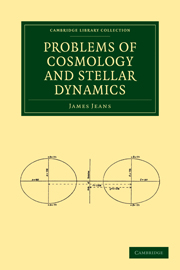Book contents
- Frontmatter
- Preface
- Contents
- I Introductory Chapter
- II General Dynamical Principles
- III Ellipsoidal Configurations of Equilibrium
- IV The Gravitational Potential of a Distorted Ellipsoid
- V Pear-shaped Configurations of Equilibrium
- VI Motion when there are no Stable Configurations of Equilibrium
- VII The Motion of Compressible and Non-homogeneous Masses
- VIII The Evolution of Gaseous Masses
- IX The Evolution of Rotating Nebulae
- X The Evolution of Star-Clusters
- XI The Evolution of Binary and Multiple Stars
- XII The Origin and Evolution of the Solar System
- Index
- Plate section
XI - The Evolution of Binary and Multiple Stars
Published online by Cambridge University Press: 05 October 2010
- Frontmatter
- Preface
- Contents
- I Introductory Chapter
- II General Dynamical Principles
- III Ellipsoidal Configurations of Equilibrium
- IV The Gravitational Potential of a Distorted Ellipsoid
- V Pear-shaped Configurations of Equilibrium
- VI Motion when there are no Stable Configurations of Equilibrium
- VII The Motion of Compressible and Non-homogeneous Masses
- VIII The Evolution of Gaseous Masses
- IX The Evolution of Rotating Nebulae
- X The Evolution of Star-Clusters
- XI The Evolution of Binary and Multiple Stars
- XII The Origin and Evolution of the Solar System
- Index
- Plate section
Summary
THE PROCESS OF FISSION
The motion of our hypothetical mass of nebulous matter has now been traced out through its earlier stages in which it formed a rotating nebula, and through its later stages in which this nebula condensed into stars. In the last chapter we considered the general nature of the motion to be expected in the cluster of stars so formed; the present chapter will be devoted to the further history of individual stars.
We have supposed that an individual star comes into existence as a condensation in a nebular arm. In this earliest period of its existence its mean density is very low, being perhaps of the order of 10-17 grammes per cubic centimetre, and its surrounding atmosphere is contiguous with that of the neighbouring stars. At this stage it shares in the rotation of the nebula of which it forms part, the period of this rotation being perhaps of the order of 160,000 years.
As time proceeds the arms of the nebula expand while individual stars contract, so that the stars become continually more distinct from one another until finally they may be regarded as entirely separate bodies, each describing its independent orbit under the gravitational attractions of the other stars.
- Type
- Chapter
- Information
- Problems of Cosmology and Stellar Dynamics , pp. 246 - 268Publisher: Cambridge University PressPrint publication year: 2009First published in: 1919

